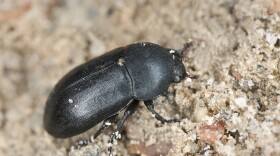
Field Notes
Wed. at 3:53 p.m., Sat. at 11:53 a.m.
Nature notes and inquiry from the Montana Natural History Center.
-
On the suggestion of an experienced birder, I bought a wire wreath and stuffed it with unshelled peanuts. The magpies spent hours skirmishing with each other to grab a peanut. I reveled in the mayhem.
-
There were tulip poplars, also known as yellow poplars or tulip trees. No tulip maples. I’d thought I’d seen the real thing in Washington, DC. No such beauties adorned my backyard.
-
Throughout history, people have been captivated by owls. There are 260 species of owls across the planet. They can be found on every continent except Antarctica.
-
I’ve always been fascinated by ruffed grouse. For such a small, skittish-seeming bird, they have a hugely outsized presence in the soundscape of the forest.
-
It’s easy to see how the nighthawks’ idiosyncrasies make them a crowd favorite, but what I love most about them are the cherished memories they resurrect.
-
A lone Sandhill Crane stood at the edge of the marsh feeding, its bill dipping repeatedly through the mud with a series of rapid, steady bursts reminiscent of a sewing machine’s insistent motion.
-
Earthworms use their entire body to breathe. Burrowed deep in the ground — slow moving, slow metabolizing — their long frames tighten and relax and pull the air they need from soil.
-
They looked like bulging stockings decorating a mantle at Christmastime. They were certainly gifts of a sort for our winter-weary senses. These were the unique nests of Bullock's Orioles.
-
In the natural world, how to persist—how, even, to improve—in the face of limits and uncertainty can be a punishing question.
-
As I drove home from Missoula, I was alarmed to see wildfire smoke across the freeway from my house in Frenchtown. Even more concerning was the convoy of pickups pulling stock trailers.
-
We have three species of garter snakes in Montana. The snake couple I saw were the terrestrial species, Thamnophis elegans, who can lack the colorful markings of the other two.
-
In late 2020 I’m spending mornings masked, working in a lab in the University of Montana Zoological Museum. The museum houses research collections of natural artifacts like skins and skeletons. But behind the scenes museum staff tend a single living collection: a colony of dermestid beetles, the meticulous scavengers that scour flesh from bones before a skeleton can be installed in the museum.
-
My sister and I struggle to keep up with our mother. Today, we carry gallon-sized Ziploc bags, rolling the nearly-black berries from their stems to our palms to our bags.
-
This Montana prairie holds a secret. This is coulee country, a landscape peppered with gullies waiting to be explored.
-
A visitor to the Yellowstone National Park helped with a calf struggling to cross a river. After, the calf began approaching people and cars, hazardous for all concerned.
-
Wind has a way of blowing in and cutting short an adventure. It can ruin a picnic. It can wreak havoc on the best-laid plans. At its worst, it can be dangerous and even deadly. But it also creates the breeze that shakes the leaves of quaking aspen. It carries the seeds of black cottonwood and the wings of Red-tailed Hawks to new destinations.
-
Most plants conduct photosynthesis and make their own food from sunlight, carbon dioxide and water. Fungus flowers, however, cannot conduct photosynthesis, making them not only look bizarre but function in a bizarre manner.
-
Tyrell’s tufted, along with most jumping spider species, is not aggressive. Jumping spiders actively hunt their food using their speed, the hunters of the arachnid world.
-
We continue walking, giving the shoreline a wide berth to avoid scaring any loons that might be around. Now we're on the opposite side of the lake and—we see them. Two adult Common Loons. Oh, they're lovely: streamlined, low-slung bodies, perfect for diving. Sleek black heads, red eyes, and characteristic black-and-white coloration that makes it easy to identify them.
-
It’s June and I’m in a dreamy meadow deep in the backcountry of Mount Rainier National Park, looking for toads. My mission: find the toads, count the toads, save the toads—in that order.
-
Crawdads have specialized cells in their exoskeletons that allow them to change color to adapt to their surroundings. The cells, called chromatophores, work to either concentrate or disperse pigment. Similar cells in chameleons and octopuses allow for a quick color change. But, for crawdads, the process is slower.
-
Northern Harriers are considered one of the most elusive raptors, and some of the most accomplished wildlife photographers admit how difficult they are to photograph. Male Harriers, with their white underside and opaque gray-back plumage, seem to be even more challenging to photograph than the brown and much larger females. For that reason, many birders and photographers call male Harriers “Gray Ghosts.”. One moment they’re in your viewfinder, the next, they’re gone.























